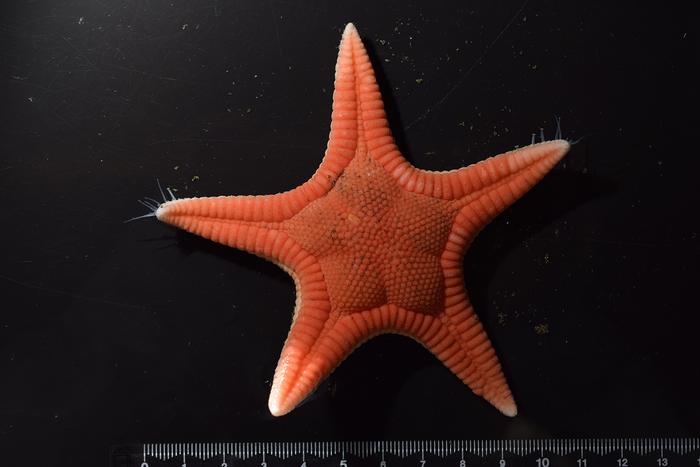Researchers in Japan have discovered a new species of starfish. The discovery came about thanks to collaborative work among researchers, fishers, and aquarium and museum staff. The starfish, which has been named Paragonaster hoeimaruae, belongs to the family Pseudarchasteridae. It is a distinctive red and beige color, with five arms and spans just over 10 centimeters. The researchers say this discovery shows the importance and benefits of working together to better understand the diversity of our oceans.

Credit: I. Kobayashi
Researchers in Japan have discovered a new species of starfish. The discovery came about thanks to collaborative work among researchers, fishers, and aquarium and museum staff. The starfish, which has been named Paragonaster hoeimaruae, belongs to the family Pseudarchasteridae. It is a distinctive red and beige color, with five arms and spans just over 10 centimeters. The researchers say this discovery shows the importance and benefits of working together to better understand the diversity of our oceans.
Did you know that starfish are not really fish? Despite the name, they are more closely related to spiky sea urchins and squishy sea cucumbers. While they may appear docile and floppy stranded on a sandy beach, they are actually important predators which can have up to 50 arms, span a meter and live for decades.
There are about 2,000 known species of starfish. Now, a collaboration among researchers at the University of Tokyo, Enoshima Aquarium, Marine Science Museum, Fukushima Prefecture and the Yamaguchi Prefectural Fisheries Research Center in Japan has led to the discovery of a new species around the country’s coast.
The new species belongs to a family of starfish called Pseudarchasteridae. Until now, only four species of Pseudarchasteridae, of two genera (biological ranking, between family and species, for classifying animals), had been seen in Japanese waters.
“We discovered the starfish – newly named Paragonaster hoeimaruae – off the coast of the Izu Peninsula in the Sagami Bay, south of Tokyo. We also found another in the Sea of Japan, northwest of Yamaguchi Prefecture in southwestern Japan,” explained lead researcher Itaru Kobayashi from the Misaki Marine Biological Station of the University of Tokyo. “They were caught between 150 meters and 350 meters deep, have a well-proportioned body with five arms, and are a beautiful red on the surface and beige underneath.”
The team gathered a variety of species from around Japan between 2021 and 2023. They were collected from shrimp and crab cages used by fishers in Hokkaido and Shizuoka prefectures, in northern and central Japan, respectively, and beam trawl surveys (where a large net is dragged across the ocean floor) conducted by a Yamaguchi prefectural fisheries research ship. The starfish’s name hoei was taken from the fishing vessel Hoei-maru, which first collected the specimen.
The team also recorded other starfish in locations different to where they had previously been found. Of particular note was Gephyreaster swifti, a surprisingly large starfish about 30 centimeters in diameter, found off the north coast of Hokkaido. Previously, it had only been recorded across the Pacific west coast of the United States and Canada along to islands in the Bering Sea to the north.
“About 250 species of starfish live around Japan, and we were surprised that one so large as this had been overlooked. Our research highlights how the diversity of species in Japanese waters is still underestimated,” said Kobayashi. “These exciting discoveries show how important it is for fishers, aquariums, universities and other research institutions to work together to better understand our oceans and marine biodiversity.”
#####
Paper
Itaru Kobayashi, Takayuki Sonoyama, Mai Hibino, Mitsuhisa Kawano and Hisanori Kohtsuka. Pseudarchasteridae (Asteroidea: Paxillosida) in Japanese waters, with description of a new species and range extension of three species. 2nd August 2024. Journal of Natural History. Doi: 10.1080/00222933.2024.2377336
Funding:
This study was supported by the Research Institute of Marine Invertebrates under Grant [KO2023, No. 5]. The specimens that were collected during the project ‘Marine Fisheries Stock Assessment and Evaluation for Japanese Waters’, were supported by the Japan Fisheries Agency.
Declaration/ conflicts of interest:
N/A
Useful Links
Graduate School of Science: https://www.s.u-tokyo.ac.jp/en/index.html
Misaki Marine Biological Station:https://www.mmbs.s.u-tokyo.ac.jp/wp-en/
Enoshima Aquarium: https://www.enosui.com/en/index.html
Marine Science Museum, Fukushima Prefecture (Aquamarine Fukushima):
Research Contact:
Project Academic Specialist Itaru Kobayashi
Misaki Marine Biological Station, Graduate School of Science,
The University of Tokyo, 1024 Koajiro, Misaki, Miura, Kanagawa 238-0225, Japan
Tel: 046-881-4107
Email: itarukobayashi@mmbs.s.u-tokyo.ac.jp
Press contact:
Mrs. Nicola Burghall (she/her)
Public Relations Group, The University of Tokyo,
7-3-1 Hongo, Bunkyo-ku, Tokyo 113-8654, Japan
press-releases.adm@gs.mail.u-tokyo.ac.jp
About the University of Tokyo
The University of Tokyo is Japan’s leading university and one of the world’s top research universities. The vast research output of some 6,000 researchers is published in the world’s top journals across the arts and sciences. Our vibrant student body of around 15,000 undergraduate and 15,000 graduate students includes over 4,000 international students. Find out more at www.u-tokyo.ac.jp/en/ or follow us on X (formerly Twitter) at @UTokyo_News_en.
Journal
Journal of Natural History
Method of Research
Observational study
Subject of Research
Animals
Article Title
Pseudarchasteridae (Asteroidea: Paxillosida) in Japanese waters, with description of a new species and range extension of three species.
Article Publication Date
2-Aug-2024



